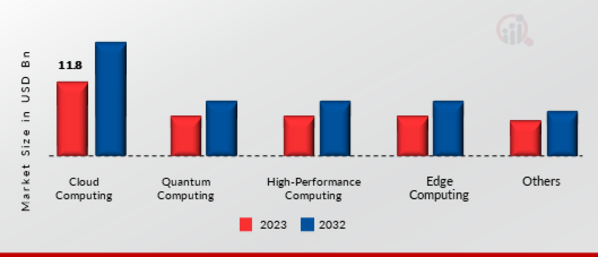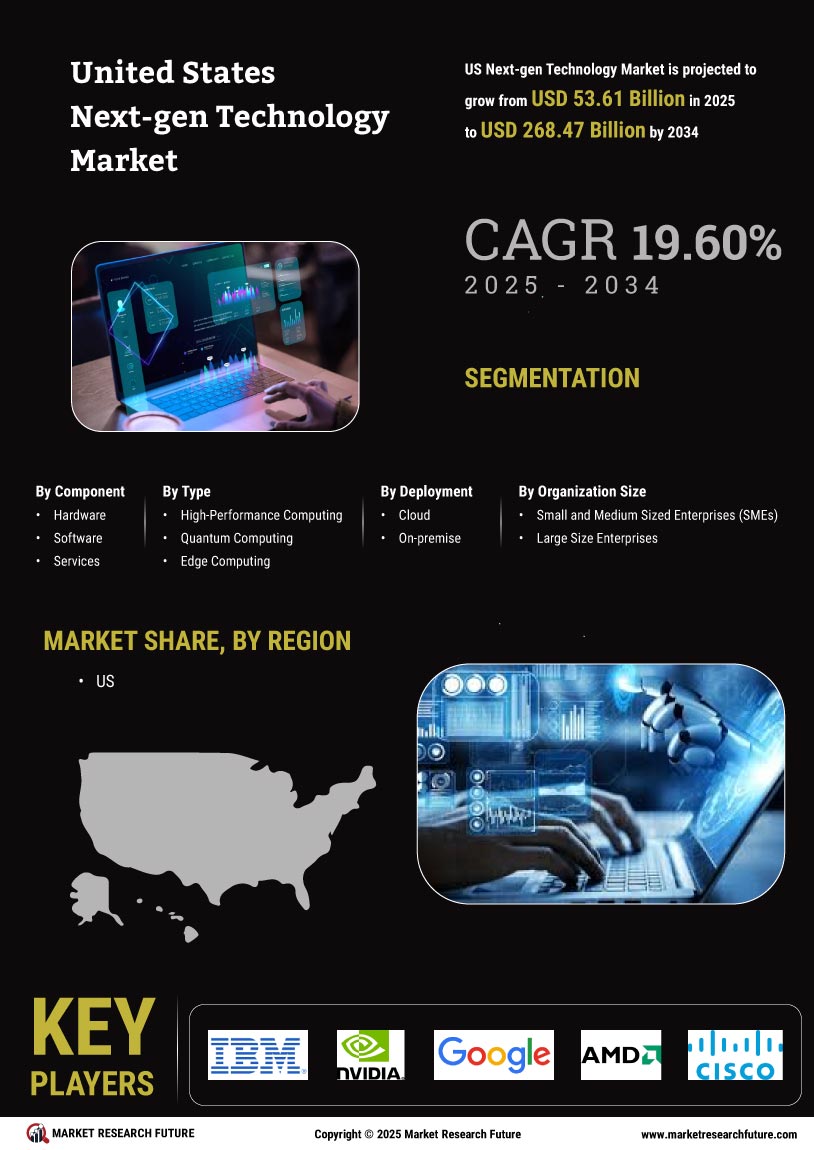United States Next-gen Technology Market Overview
US Next-gen Technology Market is projected to grow from USD 53.61 Billion in 2025 to USD 268.47 Billion by 2034, exhibiting a compound annual growth rate (CAGR) of 19.60% during the forecast period (2025 - 2034). Additionally, the market size for US Next-gen Technology Market was valued at USD 44.82 billion in 2024.
The expansion of the next-gen technology market in the United States is being driven by market drivers, including the increase in R&D efforts among technology businesses and the growing requirement to handle and manage enormous volumes of data.
Figure 1: United States Next-gen Technology Market Size, 2025-2034 (USD Billion)

Source: Secondary Research, Primary Research, Market Research Future Database and Analyst Review
United States Next-gen Technology Market Trends
Rapid Innovation in Healthcare Sector to Boost the Market Growth
Rising Innovation in healthcare is a major force behind the next-gen technology sector in the United States, spurring developments that transform patient care, business productivity, and medical research. The healthcare ecosystem urgently needs to include cutting-edge technologies due to the aging population, the rise in chronic diseases, and the need for individualized healthcare solutions. The delivery of healthcare services is changing as a result of next-gen technologies that enable early disease detection, proactive health management, remote consultations, wearable health devices, and remote patient monitoring systems.
Furthermore, healthcare clinicians are empowered with actionable information for well-informed decision-making and customized treatment regimens using digital health solutions that include electronic health records (EHRs), health informatics, and data analytics. By utilizing big data analytics, AI algorithms, and genetics, precision medicine can provide personalized treatments and predictive insights that enhance patient outcomes while lowering medical expenses.
The next-gen technology market in the United States is mostly driven by the rising demand for cloud computing and data analytics services. Adopting advanced analytics solutions becomes essential as companies work to glean insights from the massive amounts of data collected every day. This demand results from the desire to improve decision-making procedures, streamline operations, and acquire a competitive advantage in today's data-driven economy. Moreover, cloud computing services are essential for offering scalable storage and infrastructure to support data analytics projects.
Businesses use cloud platforms to have on-demand access to computing resources, which makes it easier to design and implement analytics applications quickly. Additionally, cloud-based solutions' affordability and adaptability let companies of all kinds leverage data analytics' potential without having to make large upfront infrastructure investments. Thus, driving the next-gen technology market revenue.
United States Next-gen Technology Market Segment Insights
Next-gen Technology Component Insights
The United States Next-gen Technology market segmentation, based on component, includes Hardware, Software, and Services. The hardware segment dominated the market mostly. The quick development and uptake of cutting-edge technologies like 5G connectivity, artificial intelligence, and the Internet of Things (IoT) is one important factor. In order for these technologies to work properly, strong and specialized hardware components are needed, which increases the demand for sensors, communication modules, and high-performance CPUs.
Next-gen Technology Type Insights
The United States Next-gen Technology market segmentation, based on type, includes High-Performance Computing, Quantum Computing, Edge Computing, Cloud Computing, and Others. The cloud computing category generated the most income. The primary reason for the growing popularity of cloud computing is its cost-effectiveness, flexibility, scalability, and disaster recovery. Pay-as-you-go cloud computing is a technique that lowers infrastructure costs for enterprises.
Figure 2: United States Next-gen Technology Market, by Type 2023 & 2032 (USD Billion)

Source: Secondary Research, Primary Research, Market Research Future Database and Analyst Review
Next-gen Technology Deployment Insights
The United States Next-gen Technology market segmentation, based on deployment, includes Cloud and On-premise. The on-premise category generated the most income. Better data security and compliance are provided by on-premises implementation for a range of end-user industries. The on-premises deployment model also gives enterprises more control over data, technology, and software.
Next-gen Technology Organization Size Insights
The United States Next-gen Technology market segmentation, based on Organization Size, includes Small and Medium Sized Enterprises (SMEs) and Large Size Enterprises. The large-size enterprises category generated the most income due to the increased complexity of commercial operations and the demand for simple procedures, which fuels intense industry competition.
Next-gen Technology End-use Insights
The United States Next-gen Technology market segmentation, based on end-use, includes Automotive & Transportation, Energy & Utilities, BFSI, Healthcare, Aerospace & Defense, Manufacturing, Media & Entertainment, IT & Telecom, Retail, and Others. The IT & telecom category generated the most income. The future of the IT and telecom industries is being shaped by significant developments in 5G technology, AI and machine learning, quantum computing, and cloud computing. The telecom and IT sectors are undergoing constant innovation, which makes them more and more dependent on next-gen technology and contributes to their domination.
Next-gen Technology Country Insights
The United States' next-gen technology industry is expected to increase due to many technological advancements such as artificial intelligence, quantum computing, machine learning, blockchain technology, Internet of Things (IoT), cybersecurity, 5G connectivity, and augmented and virtual reality (AR and VR). Furthermore, rising demand for cloud computing services, driverless cars, renewable energy technologies, and data analytics all help to propel the United States' next-gen technology market forward. The federal and state governments' financing and policies that encourage research and development in emerging technologies also contribute to the expansion of the market.
The commercialization of next-gen technology is propelled forward by the increased investments made by corporate investors, venture capital firms, and private equity firms. Furthermore, the market is developing because of the rising demand from consumers for cutting-edge goods and services, including wearables, smart home appliances, and customized digital experiences.
United States Next-gen Technology Key Market Players & Competitive Insights
Leading market players are investing heavily in research and development in order to expand their product lines, which will help the next-gen technology market, grow even more. Market participants are also undertaking a variety of strategic activities to expand their footprint, with important market developments including new product launches, contractual agreements, mergers and acquisitions, higher investments, and collaboration with other organizations. To expand and survive in a more competitive and rising market climate, the next-gen technology industry must offer cost-effective items.
Major players in the next-gen technology market are attempting to increase market demand by investing in research and development operations, including IBM, NVIDIA Corporation, Google, Advanced Micro Devices, Inc., Cisco Systems Inc., Amazon Web Services, Inc., Atos SE, Microsoft, Intel Corporation, Hewlett Packard Enterprise Development LP, and Dell Inc.
Key Companies in the United States next-gen technology market include
-
Advanced Micro Devices Inc.
-
Hewlett Packard Enterprise Development LP
United States Next-gen Technology Industry Developments
Ericsson and Intel signed a strategic collaboration deal in July 2023, enabling Ericsson to incorporate Intel's 18A manufacturing technology in Ericson's next-generation 5G infrastructure. According to the deal, Intel is to make 5G SoCs targeted for Ericsson to create unique leadership solutions for the forthcoming 5G infrastructure.
In the presence of their customer Quantum Computers, In November 2022, IBM announced a new 400 Qubit-Plus Quantum Processor and an edge Next Generation Computing IBM Quantum System. These advancements are important steps in quantum hardware and also point to the beginning of an era of quantum-centric supercomputing.
In May 2020, NVIDIA Corporation announced the release of a new graphics processor that focuses on data-intensive activities related to scientific simulation, genomics, and AI training.
In February 2024, EY Edge Technologies Lab enhanced the value of data across companies with the objective of enabling edge technologies to provide insights in real time. The lab proved the modality of Generative AI to cut down manual work and device mockups and enhance data integration efficiencies in a bid to help with digital transformation.
At the end of November 2023, Nokia presented its "2030 Technological Strategy" aimed at assisting organizations to navigate future advancements. AI was the focus of the strategy, and trends such as API economy, cloud continuum, metaverse and Industry 5.0 formed its core. Further, value generation and technology advancement for future needs were seen through machines and humans working collaboratively.
In February 2024, The British authorities earmarked $57 million to enhance quantum computing with the objective of making a 'quantum-enabled economy' in the year 2033. The investment also had the part, $38 million on new quantum computers and the remaining $19 million in the Quantum Catalyst Fund, which targets practical solutions in the public sector.
In July 2023, HCLTech and Microsoft joined forces to implement HPC solutions in which HCL Tech's engineering services and Microsoft's Azure cloud HPC technologies were seamlessly integrated. Particularly, the design was to facilitate the training of 3000 professionals and the creation of a lab paces the means for launching HPC solutions for R&D activities at an early stage.
In July 2023, HCLTech and Microsoft collaborated to launch HPC solutions, leveraging HCLTech's engineering services and Microsoft's Azure cloud HPC technologies. The partnership aimed to train 3,000 professionals and establish a dedicated lab for early-stage R&D in HPC solutions.
United States Next-gen Technology Market Segmentation
Next-gen Technology Component Outlook
Next-gen Technology Type Outlook
Next-gen Technology Deployment Outlook
Next-gen Technology Organization Size Outlook
Next-gen Technology End-use Outlook
| Report Attribute/Metric |
Details |
| Market Size 2024 |
44.82 (USD Billion) |
| Market Size 2025 |
53.61 (USD Billion) |
| Market Size 2034 |
268.47 (USD Billion) |
| Compound Annual Growth Rate (CAGR) |
19.60% (2025 - 2034) |
| Report Coverage |
Revenue Forecast, Competitive Landscape, Growth Factors, and Trends |
| Base Year |
2024 |
| Market Forecast Period |
2025 - 2034 |
| Historical Data |
2019 - 2023 |
| Market Forecast Units |
USD Billion |
| Segments Covered |
Component, Type, Deployment, Organization Size, End-use, and Region |
| Countries Covered |
United States |
| Key Companies Profiled |
IBM, NVIDIA Corporation, Google, Advanced Micro Devices, Inc., Cisco Systems Inc., Amazon Web Services, Inc., Atos SE, Microsoft, Intel Corporation, Hewlett Packard Enterprise Development LP, and Dell Inc. |
| Key Market Opportunities |
Consistent innovation and research and development expenditures |
| Key Market Dynamics |
Expansion of data from multiple sources, such as sensors, social media, and Internet of Things devices. Using cloud computing allows businesses to take advantage of flexible and scalable infrastructure. |
Frequently Asked Questions (FAQ):
The United States Next-gen Technology market size was valued at USD 44.82 Billion in 2024.
The market is projected to grow at a CAGR of 19.60% during the forecast period, 2025-2034.
The key players in the market are IBM, NVIDIA Corporation, Google, Advanced Micro Devices, Inc., Cisco Systems Inc., Amazon Web Services, Inc., Atos SE, Microsoft, Intel Corporation, Hewlett Packard Enterprise Development LP, and Dell Inc., among others.
The cloud computing category dominated the market in 2023.
The on-premise category had the largest share of the market.
















